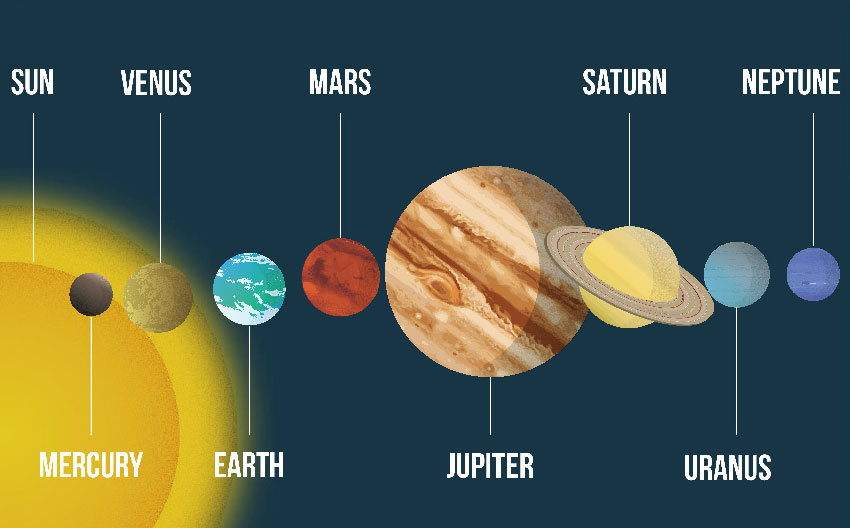सामान्य विज्ञान (General)

31 August 2020
वस्त्रप्रावरणाची निवड व त्यांची योग्य ती देखभाल
23 October 2020
या नावांमागे दडलंय काय?
12 November 2020
नोबेल पारितोषिक
8 December 2020
सूक्ष्म कणांचे तुलनात्मक आकार (The Relative Size of Particles)
Article in English संपूर्ण लेख इथे वाचा8 December 2020
दूध एक पूर्णान्न
5 February 2021
ध्यासपर्व
18 March 2021
आपल्या सूर्यमालेतील ग्रह
Article in English संपूर्ण लेख इथे वाचा
1 April 2021
ऑक्सिजन प्लॅन्टमधील ऑक्सिजन निर्मिती
26 May 2021
Planets in our solar system
1 Apr. 2021
Sequence of Planets from the Sun

Relative sizes of the planets

Characteristics of the Planets in our Solar System
Dear students,
Before you read the table given on next page, you may need an explanation of the term 'Apparent size from earth' given in the 7th column of the table.
In this column you will find that apparent sizes are written in arc seconds.
What is arc second? 1arc degree= 60 arc minutes, 1 arc minute= 60 arc seconds.
When we see a planet from the Earth, the angle subtended by the planet's diameter (angular diameter) to our eye is expressed in arc second.
Thus the value of arc seconds depends on the diameter of an object and the object's distance from the Earth.

An example, the Sun and the Moon appear to be of the same size in Earth’s sky. That is because the Sun’s diameter is about 400 times greater than that of the Moon, but the sun is also about 400 times farther away.
The total eclips of the Sun occurs because of the same apparent sizes of the Sun and the Moon as seen from earth.

The Planets in Our Solar System
** Planet (or Dwarf Planet) |
Distance from the Sun (Astronomical Units miles km) |
Period of Revolution Around the Sun (1 planetary year) |
Period of Rotation (1 planetary day) |
Mass (kg) |
Diameter (miles km) |
Apparent size from Earth |
Temperature (K Range or Average) |
Number of Moons |
|---|---|---|---|---|---|---|---|---|
| Mercury | 0.39 AU, 36 million miles 57.9 million km |
87.96 Earth days | 58.7 Earth days | 3.3 x 1023 | 3,031 miles 4,878 km |
5-13 arc seconds | 100-700 K mean=452 K |
0 |
| Venus | 0.723 AU 67.2 million miles 108.2 million km |
224.68 Earth days | 243 Earth days | 4.87 x 1024 | 7,521 miles 12,104 km |
10-64 arc seconds | 726 K | 0 |
| Earth | 1 AU 93 million miles 149.6 million km |
365.26 days | 24 hours | 5.98 x 1024 | 7,926 miles 12,756 km |
Not Applicable | 260-310 K | 1 |
| Mars | 1.524 AU 141.6 million miles 227.9 million km |
686.98 Earth days | 24.6 Earth hours =1.026 Earth days |
6.42 x 1023 | 4,222 miles 6,787 km |
4-25 arc seconds | 150-310 K | 2 |
| Jupiter | 5.203 AU 483.6 million miles 778.3 million km |
11.862 Earth years | 9.84 Earth hours | 1.90 x 1027 | 88,729 miles 142,796 km |
31-48 arc seconds | 120 K (cloud tops) |
67 (18 named plus many smaller ones) |
| Saturn | 9.539 AU 886.7 million miles 1,427.0 million km |
29.456 Earth years | 10.2 Earth hours | 5.69 x 1026 | 74,600 miles 120,660 km |
15-21 arc seconds excluding rings |
88 K | 62 (30 unnamed) |
| Uranus | 19.18 AU 1,784.0 million miles 2,871.0 million km |
84.07 Earth years | 17.9 Earth hours | 8.68 x 1025 | 32,600 miles 51,118 km |
3-4 arc seconds | 59 K | 27 (6 unnamed) |
| Neptune | 30.06 AU 2,794.4 million miles 4,497.1 million km |
164.81 Earth years | 19.1 Earth hours | 1.02 x 1026 | 30,200 miles 48,600 km |
2.5 arc seconds | 48 K | 13 |
| Pluto (a dwarf planet) | 39.53 AU 3,674.5 million miles 5,913 million km |
247.7 years | 6.39 Earth days | 1.29 x 1022 | 1,413 miles 2,274 km |
0.04 arc seconds | 37 K | 4 |
** Content courtesy www.enchantedlearning.com
Send us your feedback
All diagrams, pictures, tables etc. are from websites on Internet. We are thankful to all these sources.
Vidnyanvahini is a Non-Governmental Organisation (NGO) and this entire write up is for students, teachers and general public, free of charge.
IT IS NOT FOR ANY COMMERCIAL USE.
